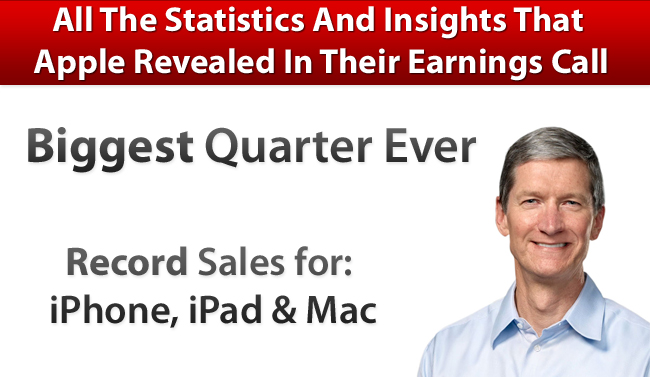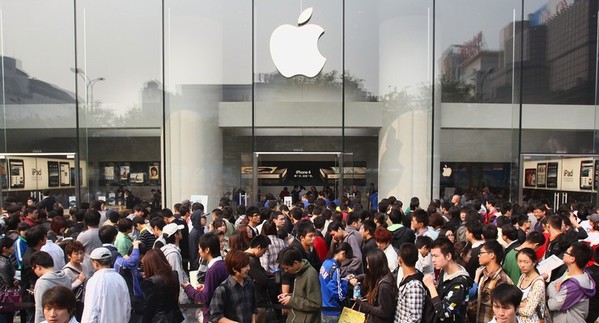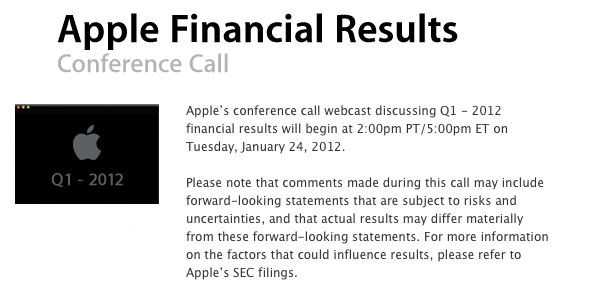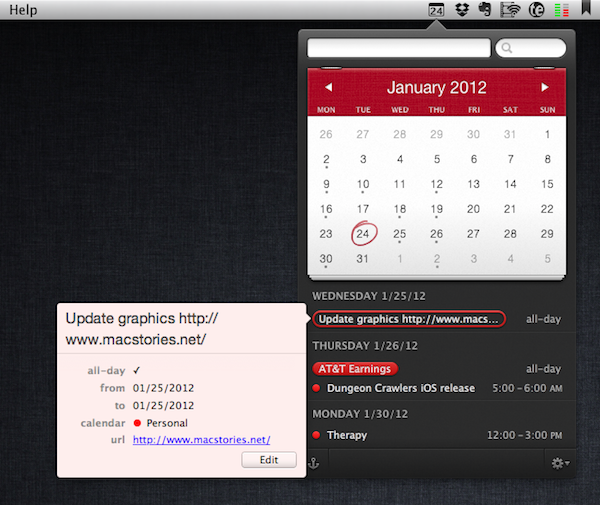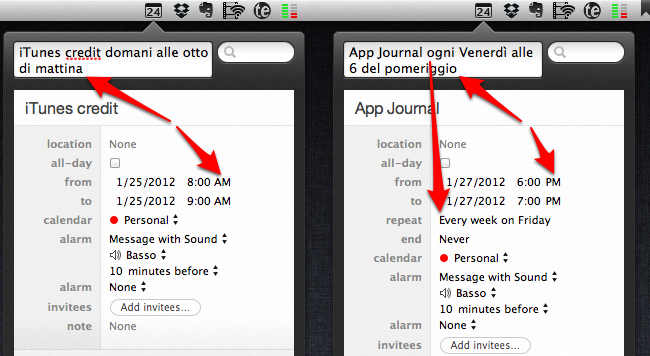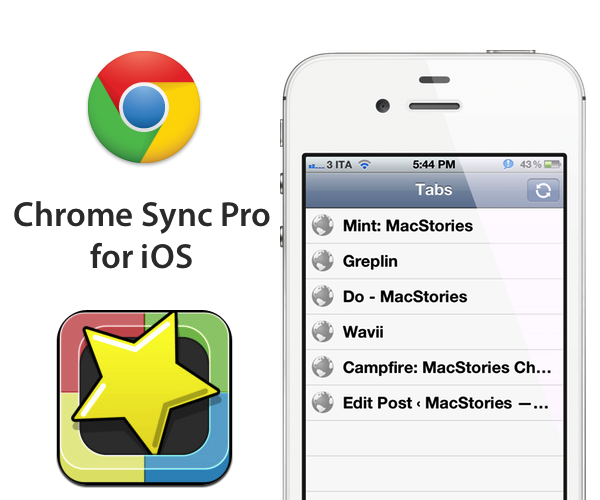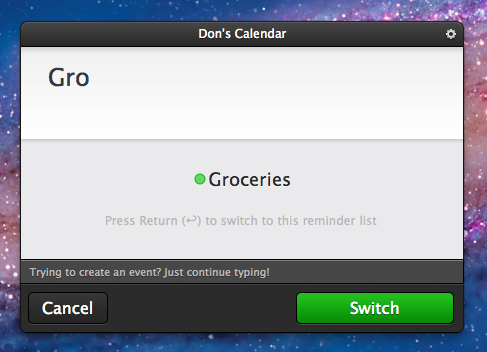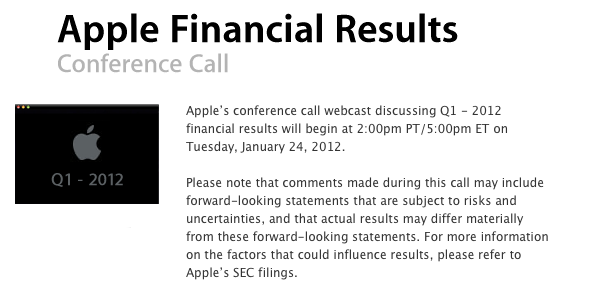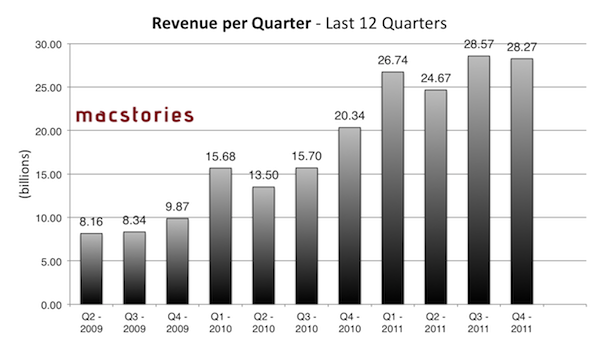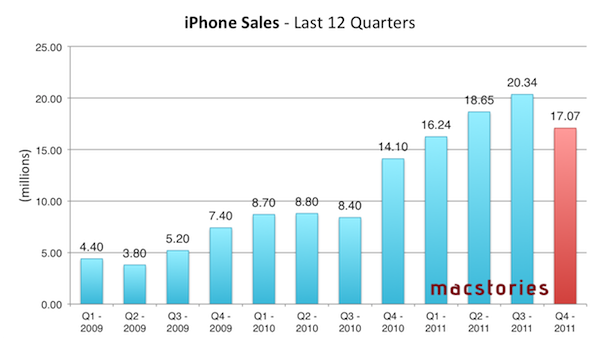At 2 PM PT, Apple is set to announce its financial results for the quarter that ended on December 24th, 2011. According to several analysts polled in the past weeks and Apple’s own guidance for the quarter, Q1 2012 is on track to become Apple’s biggest quarter to date both in terms of sales (with expected record iPhone and iPad sales) and revenue. Until today, Apple’s most profitable quarter has been Q3 2011 with $28.57 billion revenue. Below, we’ve compiled a breakdown of Q1 2012 estimates with a recap of what happened during the quarter.
Estimates and Previous Quarters
During last quarter’s earnings call, Apple said they were expecting $37 billion in revenue and diluted earnings per share of around $9.30 for this quarter. As Apple’s guidance for future quarters is historically low and conservative, the already high projection of $37 billion led bloggers to speculate Apple’s Q1 2012 would be a blowout quarter; some analysts, on the other hand, usually don’t pay attention to Apple’s guidance as the company lowballs expectations for the upcoming quarter.
Analysts and bloggers polled in the past few weeks had different takes on what Apple will report later today. Some of them, such as Robert Paul Leitao, Horace Dediu and Navin Nagrani projected revenue above $44 billion with iPhone sales of 34-35 million units and iPad sales in the range of 13 million units; as we reported three weeks ago, Asymco’s Horace Diedu estimates that Apple will report earnings of $12.3 on revenues of $44.6 billion, with the street price aiming at $9.75 EPS on $37.99 billion. As Philip Elmer-Dewitt also noted, analysts’ estimates need to be taken carefully, as several of them were released after the previous quarter’s results, and were never updated reflecting changes that took place through the quarter (such as fluctuating iPhone demand and international product launches).
Fortune’s comprehensive list of estimates for Q1 2012 is available here.
As far as iPhone sales are concerned (in Q4 2011, the device accounted for 47% of Apple’s revenue), this quarter will see Apple finally providing some actual insight into the iPhone 4S’ performance on the market. The device is well-regarded as a success on various international markets and the United States, but the only real numbers Apple posted referred to the opening weekend. Predictions for Q1 2012 go as high as 35 million units sold (those would indicate cumulative sales for iPhone 4, 4S and 3GS, not just the iPhone 4S), with an approximate figure of 30 million units sold being shared the majority of analysts and bloggers.
According to Nielsen, the launch of the iPhone 4S had an “enormous impact” on smartphone owners:
Among recent acquirers, meaning those who said they got a new device within the past three months, 44.5 percent of those surveyed in December said they chose an iPhone, compared to just 25.1 percent in October. Furthermore, 57 percent of new iPhone owners surveyed in December said they got an iPhone 4S.
This morning, Verizon Wireless reported 4.2 million iPhone activations. Reuters wrote Verizon’s “business was hit by the high costs of sales of advanced phones such as the Apple Inc iPhone.”
In Q4 2011, Apple posted revenue of $28.27 billion, with 11.12 million iPads, 17.07 million iPhones and 4.89 million Macs sold. The company posted quarterly net profit of $6.62 billion, or $7.05 per diluted share. iPhone represented a 21 percent unit growth over the year-ago quarter; iPod sales were down 27 percent from the year-ago quarter, and Apple reported the best iPad quarter to date with over 11 million units sold and a 166% increase over the year-ago quarter. In the year-go quarter, Apple posted revenue of $26.74 billion with 7.33 million iPads, 16.24 million iPhones and 4.13 million Macs sold. Read more


